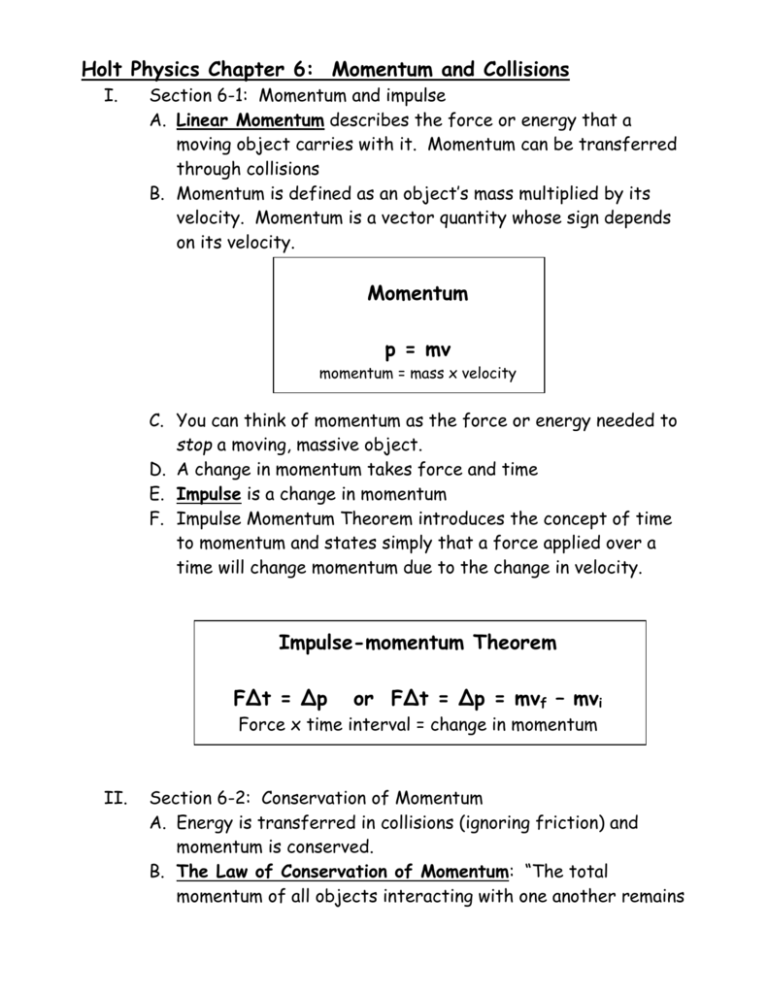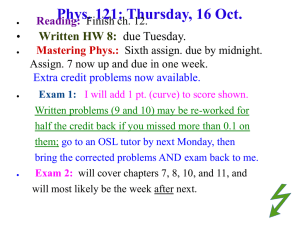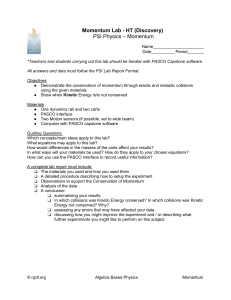Holt Physics Chapter 6: Momentum and Collisions
advertisement

Holt Physics Chapter 6: Momentum and Collisions I. Section 6-1: Momentum and impulse A. Linear Momentum describes the force or energy that a moving object carries with it. Momentum can be transferred through collisions B. Momentum is defined as an object’s mass multiplied by its velocity. Momentum is a vector quantity whose sign depends on its velocity. Momentum p = mv momentum = mass x velocity C. You can think of momentum as the force or energy needed to stop a moving, massive object. D. A change in momentum takes force and time E. Impulse is a change in momentum F. Impulse Momentum Theorem introduces the concept of time to momentum and states simply that a force applied over a time will change momentum due to the change in velocity. Impulse-momentum Theorem FΔt = Δp or FΔt = Δp = mvf – mvi Force x time interval = change in momentum II. Section 6-2: Conservation of Momentum A. Energy is transferred in collisions (ignoring friction) and momentum is conserved. B. The Law of Conservation of Momentum: “The total momentum of all objects interacting with one another remains constant regardless of the nature of the forces between the objects.” (p.216) C. Momentum is also conserved for objects pushing away from each other. In this scenario the momenta would be equal but opposite according to Newton’s 3rd law. D. During any collision (ignoring friction) the change in momentum of one object is equal but opposite the change in momentum of the other object. E. Forces in real collisions are not constant and friction does exist! Be Aware! III. Section 6-3: Elastic and Inelastic Collisions A. Perfectly Inelastic Collisions: Collisions that involve two objects that move together after the collision (including stationary objects) are called “perfectly inelastic” Perfectly Inelastic Collisions m1v1,i + m2v2,i = (m1 + m2) vf B. Objects in an inelastic collision are deformed during the collision and lose some kinetic energy to deformations, sound and heat. C. We can calculate this loss of kinetic energy using equations from chapter 5. D. Elastic Collisions: Collisions that involve two objects that remain separate after the collision are called “elastic collisions” E. In an elastic collision both, the total momentum and the total kinetic energy remain constant. F. Most collisions are neither elastic nor perfectly inelastic G. Objects in an elastic collision maintain or return to their original shape after the collision.







